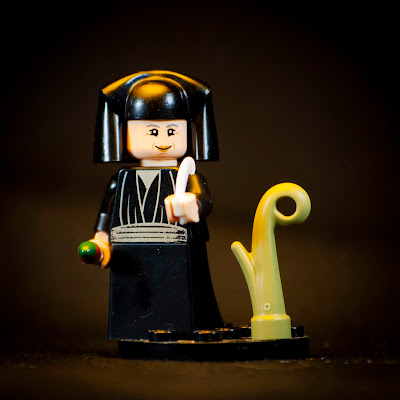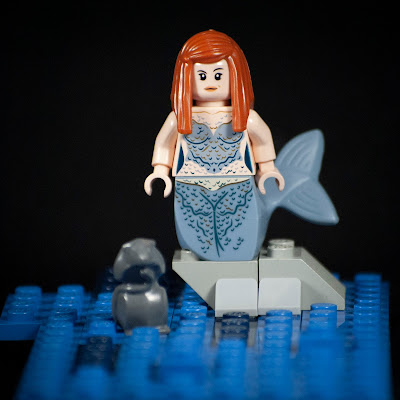St. George the Dragon Slayer
As I mentioned in my post on Muirgen, the mermaid saint, I have a particular affinity for the more mythical side of the saints' stories. Perhaps it's just because I'm a fan of fantasy, but I like to think it's because myth has a way of sneaking deeper truths around our defenses.
For an excellent example of the mythologized side of St. George, I highly recommend Margaret Hodges and Trina Schart Hyman's beautiful and moving St. George and the Dragon.
Most of the popular story of St. George is not based on history. According to legend, George was a knight in shining armor, battling a vicious dragon on the green hills of Arthurian England to save a princess from certain death.
In actuality, he was most likely an officer in the Roman military who was martyred for refusing to recant his Christian faith.
I'll tell a version somewhere in the middle.
George was born to Christian parents on the outskirts of the Roman empire, in the day before Christianity became an accepted religion there. When his father died while he was young, George and his mother moved back to her home town. A few years later, his mother died as well.
With few other options in his life as a young orphan, George joined the military, as the hungry Roman empire always needed more troops. However, George soon found that he was a skilled warrior and quickly rose in rank. While many of his peers fought for wealth, or because they enjoyed fighting, George's Christian background provided him a more compelling motive. George fought to protect the poor and sick citizens of Rome against the barbarian hordes who continually threatened to break the internal peace of Rome.
Eventually George was in command of his own unit and was given more freedom to decide what battles he would fight and where he would defend. He traveled around his area of Rome, fighting battles and keeping the peace.
One day, he arrived to a town and the people there told him that a horrible beast was burdening their village. The beast (some sources call it an alligator, others a dragon. We're going with the cooler one) lived near the spring where they got their water. Whenever someone tried to draw from the spring, it would try to eat them.
The townspeople had gotten by for a while by feeding it a goat every day as they went to draw the water. While it was eating, they could get what they needed and run again. But then they ran out of goats. Without water, all the people would die, so they made the tough decision that they would pick someone at random to feed the dragon.
When George arrived, the town was in chaos. A few townspeople had already been sacrificed, but the local king's daughter had been chosen today. He refused to let her be eaten, but the people demanded that their own children had to die for the greater good, and so should his daughter. The king swore he would have his soldiers kill anyone who tried to take his daughter, and the people threatened an uprising if he didn't yield her. Either way, many would die and lead them no closer to dealing with the dragon.
That's when George valiantly volunteered to solve the problem once and for all. He mounted his horse and left for the spring alone to battle the dragon.
It was a long and dangerous battle, and George himself was gravely wounded, but he refused to stand down. He knew that if he didn't slay the dragon, more and more of the villagers would die. But every strike of his spear just glanced off the dragon's mighty scales.
Finally, when the dragon opened its mouth to eat him, George saw his chance. Just as the dragon's teeth opened around his body, George stabbed his spear with all his might into the dragon's throat. With a deep growl, the dragon died, and the village was saved.
The king rewarded George generously for saving his daughter, but George saw the needs of the people and gave them the chests of gold instead.
George's name spread throughout Rome and he became very famous. Many people gave him gifts and rewards, which he always gave away to the poor.
But soon, the emperor started becoming concerned. George and the other Christians were starting to challenge his rule with their generosity. He set up a meeting with George and asked him to pray to the Roman gods so that the people would see that both faiths could co-exist. But George refused.
The emperor grew angry and demanded that George deny the Christian God and instead worship the Roman pantheon. George still refused. He was bribed, but he gave that money to the poor as well, and still refused to deny his God. He was tortured, and never for a moment lapsed in his faith.
Finally, the emperor gave George one last chance. He took him to the center of the city, surrounded by soldiers. He told George that if he didn't deny his God now, he would die. George ignored the emperor and instead just prayed to God to watch over the poor people of Rome when he was gone. The soldier next to him swung his sword and cut George's head off.
Thousands of people converted to the Christian faith that day because of George's martyrdom.
For an excellent example of the mythologized side of St. George, I highly recommend Margaret Hodges and Trina Schart Hyman's beautiful and moving St. George and the Dragon.
Lifetime: ~300
Region: Cappadocia (modern Turkey)
Patronages: England; Soldiers; Boy Scouts
Iconograpy: Killing a dragon; Shield with red cross; Riding a horse
Feast Day: April 23
Region: Cappadocia (modern Turkey)
Patronages: England; Soldiers; Boy Scouts
Iconograpy: Killing a dragon; Shield with red cross; Riding a horse
Feast Day: April 23
Most of the popular story of St. George is not based on history. According to legend, George was a knight in shining armor, battling a vicious dragon on the green hills of Arthurian England to save a princess from certain death.
In actuality, he was most likely an officer in the Roman military who was martyred for refusing to recant his Christian faith.
I'll tell a version somewhere in the middle.
George was born to Christian parents on the outskirts of the Roman empire, in the day before Christianity became an accepted religion there. When his father died while he was young, George and his mother moved back to her home town. A few years later, his mother died as well.
With few other options in his life as a young orphan, George joined the military, as the hungry Roman empire always needed more troops. However, George soon found that he was a skilled warrior and quickly rose in rank. While many of his peers fought for wealth, or because they enjoyed fighting, George's Christian background provided him a more compelling motive. George fought to protect the poor and sick citizens of Rome against the barbarian hordes who continually threatened to break the internal peace of Rome.
Eventually George was in command of his own unit and was given more freedom to decide what battles he would fight and where he would defend. He traveled around his area of Rome, fighting battles and keeping the peace.
One day, he arrived to a town and the people there told him that a horrible beast was burdening their village. The beast (some sources call it an alligator, others a dragon. We're going with the cooler one) lived near the spring where they got their water. Whenever someone tried to draw from the spring, it would try to eat them.
The townspeople had gotten by for a while by feeding it a goat every day as they went to draw the water. While it was eating, they could get what they needed and run again. But then they ran out of goats. Without water, all the people would die, so they made the tough decision that they would pick someone at random to feed the dragon.
When George arrived, the town was in chaos. A few townspeople had already been sacrificed, but the local king's daughter had been chosen today. He refused to let her be eaten, but the people demanded that their own children had to die for the greater good, and so should his daughter. The king swore he would have his soldiers kill anyone who tried to take his daughter, and the people threatened an uprising if he didn't yield her. Either way, many would die and lead them no closer to dealing with the dragon.
That's when George valiantly volunteered to solve the problem once and for all. He mounted his horse and left for the spring alone to battle the dragon.
It was a long and dangerous battle, and George himself was gravely wounded, but he refused to stand down. He knew that if he didn't slay the dragon, more and more of the villagers would die. But every strike of his spear just glanced off the dragon's mighty scales.
Finally, when the dragon opened its mouth to eat him, George saw his chance. Just as the dragon's teeth opened around his body, George stabbed his spear with all his might into the dragon's throat. With a deep growl, the dragon died, and the village was saved.
The king rewarded George generously for saving his daughter, but George saw the needs of the people and gave them the chests of gold instead.
George's name spread throughout Rome and he became very famous. Many people gave him gifts and rewards, which he always gave away to the poor.
But soon, the emperor started becoming concerned. George and the other Christians were starting to challenge his rule with their generosity. He set up a meeting with George and asked him to pray to the Roman gods so that the people would see that both faiths could co-exist. But George refused.
The emperor grew angry and demanded that George deny the Christian God and instead worship the Roman pantheon. George still refused. He was bribed, but he gave that money to the poor as well, and still refused to deny his God. He was tortured, and never for a moment lapsed in his faith.
Finally, the emperor gave George one last chance. He took him to the center of the city, surrounded by soldiers. He told George that if he didn't deny his God now, he would die. George ignored the emperor and instead just prayed to God to watch over the poor people of Rome when he was gone. The soldier next to him swung his sword and cut George's head off.
Thousands of people converted to the Christian faith that day because of George's martyrdom.






